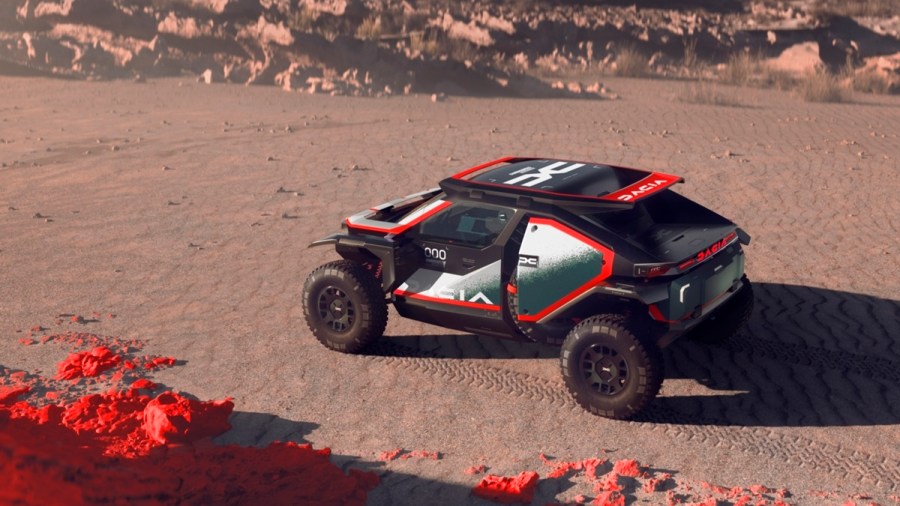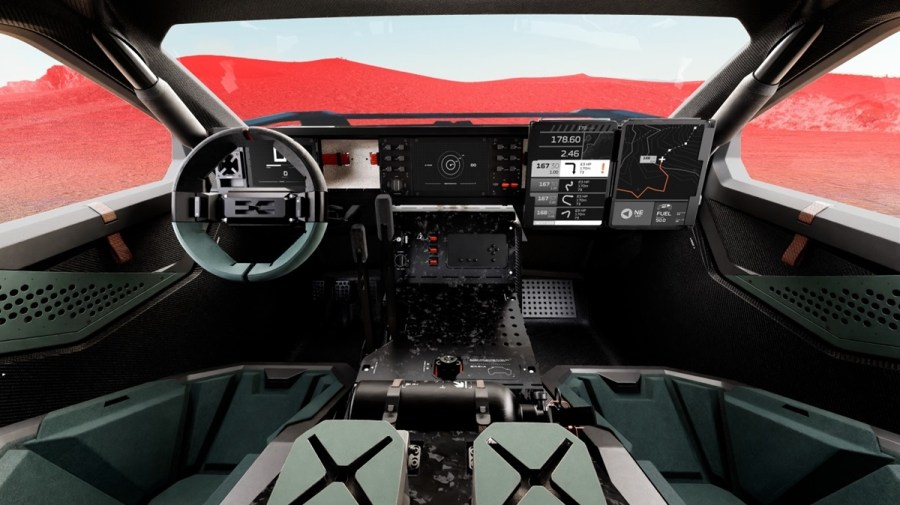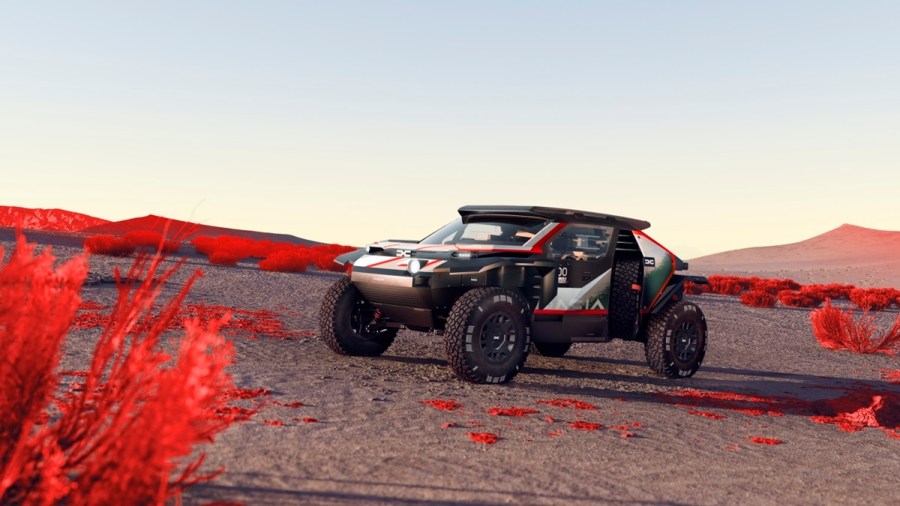The Dacia Sandrider will take on the notorious Dakar rally in 2025, powered by a Nissan Z V6 running on synthetic fuels.
The landscape is shifting in the rally raid sphere. Ford is coming along in a big way with a yet-to-be-unveiled Ranger Raptor behemoth, but after finally winning the Dakar with its hybrid RS Q e-tron, Audi is on its way out the door ahead of a big new adventure in F1. So, to keep things competitive, the World Rally Raid Championship needed a new manufacturer to step into Audi’s shoes, and that manufacturer is Dacia. However, the proposed Dacia Sandrider is a rather different vehicle to the RS Q e-tron which currently holds the Dakar crown.
See, following the eventual success for Audi and its electrically-propelled RS Q e-tron, you’d be forgiven for assuming that other manufacturers would follow in the Germans’ EV footsteps. However, that’s proven not to be the case. The upcoming Ford is set to use synthetic fuels in a combustion engine, the venerable Toyota Gazoo Racing Hilux already does, and now so too will this Dacia. And what an engine to choose. Dacia has leant on the Renault-Nissan alliance to secure itself a supply of 3.0-liter twin-turbo V6 engines, based on the VR30DDTT architecture found in the current Nissan Z! Those engines will be fueled by synthetics produced by Aramco.

Tech specs – what we know so far
Of course, the Dacia Sandrider is still a concept that’s in its infancy, however we do know a little bit about it already. Those V6 engines, for example, will be tuned to compliance with the premier T1+ regulations of the World Rally Raid Championship, meaning that they’ll actually produce less power than a standard Z. Whereas the roadgoing coupe cranks out 400hp in its stock guise, the competitive regulations dictate that the Sandrider will churn out 360hp instead. However, torque is quoted by Dacia as 539Nm (398lb ft) which is more than the Z’s figure of 350lb ft, or 384 in the Nismo variant. Another trait that the Dacia Sandrider has over the Nissan Z Nismo is a six-speed manual sequential gearbox.
The body will be constructed from carbon fiber and sit atop a tubular chassis, with double wishbone suspension at both ends. Up to 350mm of suspension travel will help the Sandrider to glide its way across tough terrain.
British motorsport legends, Prodrive, have been tasked with building the Dacia Sandrider, but they’ll receive factory assistance from the Renault Group. That should be a lethal combination given Prodrive’s prowess in the sport – as privateers, they claimed the runner’s-up medal in this year’s Dakar with their own Prodrive Hunter. And, it’s worth pointing out that they’re the team that was behind Subaru’s WRC programme, and Aston Martin’s GT racecars.

‘Essential’ design
Dacia prides itself on its philosophy of ‘essentialism’, which is basically a fancy way of saying that they’re a ‘no frills’ company. They’ll focus on what matters, and deliver those aspects the best way they can; no more, no less. That comes across in the Sandrider’s purposely straightforward design. As Dacia puts it, there are no “decorative or superfluous” parts. Whether that’s the right approach for what is essentially a halo car, I’m not sure, but for better or worse, it definitely adheres to Dacia’s brand identity.
There are some clever bits of thinking packed in. For example, although it’s based on the Dacia Manifesto concept, the raked front bodywork and anti-reflective paint have all been introduced to give Dacia’s team of drivers the best possible visibility. On the inside, the Dacia Sandrider features a modular dashboard, allowing crews to change the interior setup to their own liking. It’d be interesting to see if aspects of that ever make it to Dacia production cars…
The Romanian marque also claims that a lot of thought has gone into the Sandrider’s dynamic efficiency. Compared to “comparable prototypes” (presumably its Dakar rivals in the T1+ category?), Dacia says the Sandrider is 15kg lighter, creates 10% less drag, and 40% less lift. This should lead to better fuel efficiency and less of a need to stop during a rally stage. Speaking of stopping, should the crews ever need to change a tire, a magnetic plate on the car gives them somewhere to attach the wheel bolts, preventing them from getting lost in the desert sand.

Sébastien Loeb (left) and Cristina Gutierrez (right).
Who will race it?
Prodrive will operate the Dacia factory team and the Sandrider is set to make its competitive debut at the 2024 Rallye du Maroc in October. However, three Sandriders will be entered into the full 2025 World Rally Raid Championship, which includes the prestigious Dakar event.
9x World Rally Champion Sébastien Loeb will continue his association with Prodrive going into the new Dacia era, having led the development of the British team’s Hunter prototype which he has competed with over the past few years. With plenty of rally raid experience now under his belt, the former WRC star is primed to take his first Dakar win with Dacia.
Joining the legendary Frenchman in the team is Spanish racer, Cristina Gutierrez. Gutierrez has been making a name for herself in the lower off-road categories, and is a race winner in the Extreme E series. This top flight factory drive will be quite a step up for her, but she’s well equipped to make the most of it.
Finally, multiple Dakar winner Nasser Al-Attiyah is slated to take up the third car. However, the Qatari Olympic medalist hasn’t exactly got off to the smoothest of starts with Prodrive. To get acquainted with the team, he traded his trusty Toyota for a Prodrive Hunter in this year’s edition of the Dakar rally, in preparation for the Dacia assault next year. However, a string of problems with the Hunter resulted in Al-Attiyah walking away from the car and refusing to drive it to the finish. I suppose the only way is up, but I also wouldn’t be surprised to hear Ford knocking at his door in the near future either…








